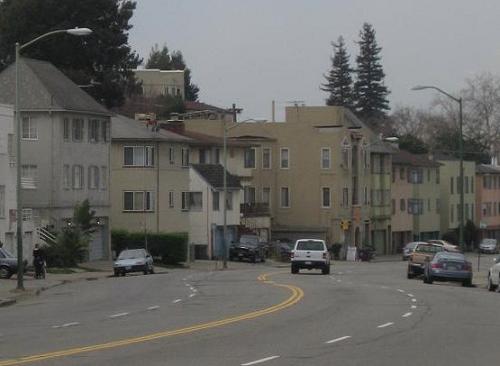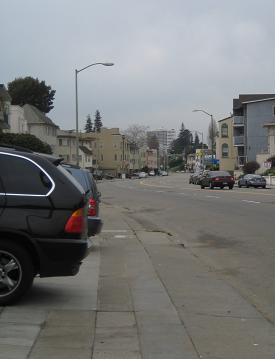The San Francisco Chronicle had a “Chronicle Watch” feature the other day about one of those solar-powered displays that cities put up to let drivers know how fast they are going (the Chron’s “Journalism of Action” in action!). The display in question, which briefly wasn’t working because its solar battery was dead, happens to be a few blocks from me on Park Boulevard (where the marchers were protesting recently).
I’ve actually spent a lot of time thinking about Park Blvd, because I face its problems every time I cross over it, walk down it, or bike up it. In some ways, Park is a nice street: it curves gently up shallow valleys and ridgelines, from humble flatland beginnings at Kragen Auto Parts and Church’s Fried Chicken to a posher terminus in hillside Montclair. There are several parks alongside the street, and numerous shops, restaurants and cafes. You wouldn’t call it bustling in the way that some other Oakland neighborhoods such as Chinatown or Fruitvale are bustling, but compared to the strip malls of Fremont or Fairfield, it’s an urbanist’s dream.
And yet lower Park, from E. 18th Street to Interstate 580, is clearly not living up to its potential; cars drive at dangerous speeds past the occasional pedestrian who stands helplessly at a crosswalk, businesses routinely disappear for lack of customers, and some neighborhood residents avoid the sidewalks and parks because they don’t feel safe.
Earlier this week, I was eating lunch outside a bagel shop on Park Street in Alameda, and I was surprised to realize that Park Street has just as many lanes as Park Boulevard. The streets could hardly feel more different: Park Boulevard often feels like a speedway running through a semi-deserted neighborhood, whereas on Park Street, the sidewalks are thick with pedestrians popping in and out of thriving businesses, drivers obey the speed limits, and people can cross the street without putting their life at risk.
I’m not a city planner or a traffic engineer, but a few explanations for Park Boulevard’s deficiencies come to mind. First is the width of the street itself. At some point, Oakland’s planners must have decided that every neighborhood should have a broad boulevard whose primary purpose would be to feed cars to freeway entrances at high volume. So in addition to the numerous highways slicing Oakland’s neighborhoods into semi-isolated chunks, there are many wide streets designed with one purpose only: to keep as many cars as possible traveling as fast as possible from the side streets to the freeways. Park Street in Alameda bears more traffic (or so I would guess) on the same number of lanes, but is a much narrower street, forcing cars to drive more slowly.
While Park Boulevard isn’t as wide as some other arteries such as 27th St. or West MacArthur, which have three wide traffic lanes in each direction, it still seems far too wide for the amount of traffic it gets. At many times of day, drivers have no other vehicles nearby, so they tend to drift from lane to lane as the road curves left and right, encouraging the sense that they are on a racetrack and not a city street. Could you really blame the guy in this white pickup if he drove this stretch of road as if he were at Indianapolis Speedway? (The radar-equipped speed sign is just around the next bend.)

And could you really blame the woman with the stroller at the left if she decided that she’d rather drive down to the nearby cafe or playground instead of making this desolate walk? Imagine if this street had one traffic lane in each direction, with perhaps a median strip, or a center lane for left turns only. Imagine wider sidewalks, with some trees planted right next to the roadway. It would no longer look like a wide open thruway, and would look a lot more like a city street built to a human scale.
In addition to the excessive width of the street, the lack of median, and the barren, narrow sidewalks, this particular stretch of Park Boulevard is entirely lacking in traffic lights or stop signs for over half a mile, from the intersection with E. 18th St. to the intersection with Spruce and 7th Avenue. Below is an aerial shot of that section of Park Blvd from Google Maps, with E. 18th marked in red at the lower left, and Spruce marked at the upper right.

You can see that this is not some remote or sparsely-populated part of the city. There are many side streets coming in, apartment buildings on all sides, a major merger/intersection with 5th Avenue (near the center of the image), two city parks on opposite sides of Park Boulevard (one of which includes a children’s play area, basketball courts, and a community center) and several crosswalks — but not a single traffic light or stop sign. And even the crosswalks that do exist are pathetic; with one exception, they are two thin lines painted across the road, instead of the thick white bars that make up a proper crosswalk.
Given the curvy thoroughfare, and the frequency of the side streets, it is almost impossible for a walker to know if a speeding car is about to appear, so even if the coast looks clear, I find myself rushing to get across. And I’m a young, agile person who isn’t usually transporting any cargo. Think about what the woman with the stroller in the photo above is facing if she wants to get to the playground: over half a mile of wide, fast street without any way to safely cross over to the park on the other side. This is almost criminal. To take her kid to the playground, she has to either walk out of her way to one of the streets that has a proper crossing light, or she has to cross her fingers, murmur a quick prayer, and take her chances at one of the “crosswalks,” or she has to get in her car (assuming she owns one) and drive to the park.
If she does decide to drive to the park, then that itself has all sorts of ramifications, none of them good. I’m not thinking of fossil fuel use or exhaust emissions; I mean more local, tangible effects. For one thing, if she chooses to drive to the playground, then the only pedestrian on that particular stretch of Park Boulevard would not be there, leaving the sidewalk entirely empty, and therefore less welcoming to any other neighborhood residents who might consider walking down to a local restaurant or the movie theater a few blocks away.
And if the woman with the stroller chooses to drive her kid to the playground, then there’s a decent chance that she will decide to go to a less local playground. The park across Park Boulevard has some history of drug dealing and related problems, and while it’s much less blighted than it used to be, the playground is still unused a lot of the time, so it would be perfectly reasonable for the woman to take her child to another park where she will be more likely to find other parents and children, and less likely to find any sort of trouble. This will in turn mean that the local playground is even more deserted that it would have been, and therefore less hospitable to prospective families and more hospitable to dealers or their customers.
I won’t descend any further into fictional speculation, but I assume the point is clear: whenever we are dealing with a complex system like a city neighborhood, where thousands of people are making thousands of decisions about where to live, where to shop, where to eat, where to play, and how to get to all those places, then things like traffic lights, median strips and populated sidewalks have consequences, and those consequences have consequences. (A good Boston Globe Magazine article in August, “The Future of Crossing the Street,” provided some fascinating examples from Boston about how urban space and human behavior interact in subtle ways.)
With fewer crossing lights, people are less likely to walk places. With fewer pedestrians around, drivers are less likely to slow down. With cars going faster, people are less likely to walk places. With fewer people walking places, the sidewalks will be more desolate, so people will feel more vulnerable to muggers (or worse). With pedestrians feeling more vulnerable, they will be less likely to want to walk places. With fewer pedestrians walking places, cars will be less likely to watch out for them, and more likely to hit them. With cars more likely to hit pedestrians, people will…you get the point: everything “ramifies endlessly,” as Philip Larkin put it.
So that solar-powered, radar-equipped speed display is all well and good if it causes drivers to slow down, but it is just a tiny start in what needs to happen to bring Park Boulevard closer to its potential. The street has a lot in its favor — the beloved Parkway Theater, several nice restaurants and coffeehouses, the two parks mentioned above, and more. If Oakland’s government wants to get serious about improving Park Boulevard and the surrounding neighborhoods, beyond installing one electronic display, then they can look across the estuary to Park Street for some guidance.
In Alameda, not only do they post a speed limit and perhaps an electronic display telling drivers how fast they are going, but they actually give tickets to drivers who speed on city streets. In Alameda, not only do they install crosswalks at intersections, but they actually make them prominently visible to drivers. In Alameda, not only do they make crosswalks visible to drivers, but they actually give tickets (and quite large ones, I hear) to drivers who fail to stop for pedestrians, even when there is no traffic light at the crossing.
I would personally much rather live in Oakland than Alameda, but that doesn’t mean that Oakland couldn’t learn a thing or two from other places about how to make the city’s neighborhoods safer and more vibrant — in other words, more citylike. I’m happy to report that I did see one small but promising sign yesterday.
 As I walked down to the Parkway to see whether there was any chance of getting in to see the inauguration there (there wasn’t — at 7:15 am, the line for the theater was already two blocks long), I saw a parking cop ticketing cars that were parked with their tail ends on the sidewalk like the ones shown here.
As I walked down to the Parkway to see whether there was any chance of getting in to see the inauguration there (there wasn’t — at 7:15 am, the line for the theater was already two blocks long), I saw a parking cop ticketing cars that were parked with their tail ends on the sidewalk like the ones shown here.
Along with cars parked in bike lanes, cars parked on sidewalks really irritate me, because the message seems to be, “My convenience is more important than your right to use a public right of way safely.” And since most of the people who park on sidewalks or in bike lanes would never consider parking in the middle of a car lane, the message also seems to be, “Cars are more important than pedestrians or bicyclists, even on sidewalks or bike lanes.” And since I see cars parked across sidewalks every day, and never see them getting ticketed for it, I always assumed that the police felt the same way. It was nice to see that at least one City of Oakland employee disagrees. Maybe she was inspired by the imminent dawn of the Obama era, or maybe she just had a quota to fill. Either way, I was happy to see it — there’s a reason they’re called sidewalks, not sideparks.
21 Comments